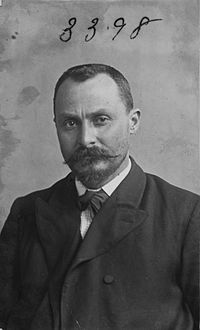Vito Cascioferro
| Vito Cascioferro | |
|---|---|

1902 mug shot of Cascioferro
|
|
| Born |
January 22, 1862 Bisacquino, Italy |
| Died | September 20, 1943 (aged 81) Procida, Italy |
| Nationality | Sicilian |
| Other names | Don Vito |
| Occupation | Mafia boss, revenue collector |
| Criminal penalty | Life imprisonment |
| Parent(s) | Accursio Cascio Ferro Santa Ippolito |
| Conviction(s) | Murder – 1930 |
Vito Cascioferro or Vito Cascio Ferro (January 22, 1862 – September 20, 1943), also known as Don Vito, was a prominent member of the Sicilian Mafia. He also operated for several years in the United States. He is often depicted as the "boss of bosses", although such a position does not exist in the loose structure of Cosa Nostra in Sicily.
Cascioferro's life is full of myth and mystery. He became a legend even when he was alive, and that legend is partially responsible for creating the image of the gallant gentleman capomafia (Mafia boss). He is widely considered to have been responsible for the 1909 murder of Joseph Petrosino, head of the New York City police department's Italian Squad. However, he was never convicted of the crime.
With the rise of Fascism in Italy, his untouchable position declined. He was arrested and sentenced to death in 1930 and would remain in jail until his death. There is some confusion about the exact year of his death, but according to La Stampa, Cascioferro died on September 20, 1943, in the prison on the island of Procida.
Although many sources have identified him as a native of the rural town of Bisacquino, where he was raised, he was actually born in the city of Palermo. His parents, Accursio Cascioferro and Santa Ippolito, were poor and illiterate. The family moved to Bisacquino when his father became a campiere (an armed guard) with the local landlord, Baron Antonino Inglese, a notorious usurper of state-owned land. The position of campiere often involved Mafiosi. According to other sources, at an early age, the family moved to Sambuca Zabut, where he lived for approximately 24 years before relocating to Bisacquino, his recognized power base in the Mafia.
Cascioferro never went to any school. When still young, Cascioferro married a teacher from Bisacquino, Brigida Giaccone, who instructed him how to read and write. He was inducted into the Mafia in the 1880s. He worked as a revenue collector as a young adult, using the position as a cover to carry out his protection racket. His criminal record began with an assault in 1884 and progressed through extortion, arson, and menacing, and eventually to the kidnapping of the 19-year-old Baroness Clorinda Peritelli di Valpetrosa in June 1898, for which he received a three-year sentence.
...
Wikipedia
